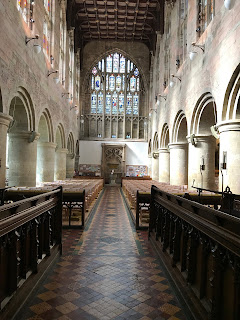-->
One hot day in
late summer we went to Malvern, listed as Malferna in the Domesday Book 1086
and classified as woodland. The name is ancient British moel-bryn or
‘Bare-Hill. The modern Welsh equivalent is Moelfryn or ‘bald hill’. The area is
rich in prehistoric remains, being positioned on a major ancient trade route
connecting the salt mines of Droitwich Cheshire to South Wales, but with only a
day to spare – a very hot day – we limited ourselves to the town and the
Priory.
It’s sobering to consider that this
great building developed from a small
settlement of Saxon hermits headed by the martyred St Werstan and favoured by Edward The
Confessor. When the Normans came its fortunes looked up as did its architecture.
The romanesque arches and heavy pillars are early Norman.
The Benedictines founded what is
now the Priory its second and perhaps greatest prior being Walcher of Lorraine.
He led a medieval mathematical revolution, observing the phases of the moon using
the astrolabe and, with Robert the Lotheringian, he translated key Arabic works
as well as Arabic numerals into England.
The monks were blessed with some beautifully carved misericords allowing them to surreptitiously sit while apparently standing.
Grotesque face
Witch on broomstick
Green man
The priory was greatly extended in
the C15th and benefited from the patronage of both Richard III and Henry VII.
The former commissioned the great West window showing Doomsday in stained glass, Henry, the fabulous Magnificat window showing Mary the mother of God in a blue
cloud studded in stars.
If you zoom ins, Mary is ensconced in the cloud, (blue wreath) near the top.
It’s even more sobering to consider
how close all this was to being obliterated, when Henry VIII dissolved and sold off
the monasteries (1536-1540). The Lady Chapel was sold for a £1 and was knocked
down, the stone no doubt being cannibalised for other buildings. The Cloisters
and South transept were similarly destroyed, the lead removed from the
roofs. The Priory Church, however, was saved by the 105 families of Malvern.
They petitioned the king and bought it from him for the princely sum of £20.
After doing so, there was no money left to adequately maintain it. That was
left – like most things – to the Victorians who restored it to its former
glory.
One great peculiarity is this magnificent tomb of John Knotsford, his wife and his daughter. Why peculiar? it holds the corpse of one of the men who destroyed much of the priory before the village bought what was left. Such historical quirks hide stories yet to be told.
The great East window showing the Crucifixion and resurrection and behind you
the West window depicting Judgement day. On a sunny day, a worshipper would be bathed in the light from both.
In fact where-ever you stood, you'd be bathed in coloured light. Malvern Priory holds the greatest number of late medieval stained glass in the country. God bless those 105 families who raised £20.
And since it was the Victorians who restored it, it seems only proper that on her Golden Jubilee,
Queen Victoria had her own window—her great nephew, the Kaiser in red military uniform stands behind her. Another quirk of history, I guess.
















5 comments:
Beautiful! I think you need to start doing videos (with commentary) of your trips.
Thanks, Maria, bur ref video's - too much hard work - and have you heard my Liverpool mumble? :)
I have relatives in Malvern and went there often as a kid but not for a long while now. I forgot how lovely it is. Thanks for the reminder :)
Hi DRC
Thanks, I'm glad it brought back memories. What I didn't say in the blog was how exceptionally friendly the people we met proved to be.. Really nice. We plan to go back and explore some walks.
Aww, their friendliness must have rubbed off on me at a young age then. Explains a lot haha!!
Post a Comment